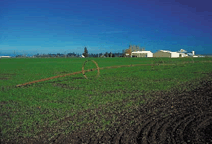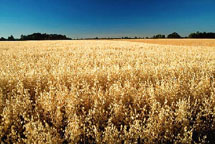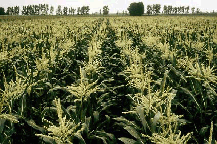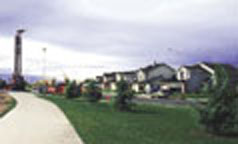
Herbicides are the most common type of pesticide found in streams and ground water within agricultural areas. The most common herbicides in agricultural streams were atrazine and its breakdown product deethylatrazin(DEA), metolachlor, cyanazine, alachlor, and EPTC. All 5 of the parent compounds rank in the top 10 in national use.
 |
| image size 58KB--jpeg |
Atrazine was found in about two-thirds of all samples from agricultural streams, often occurring year-round. Similar to streams, the most common compounds found in shallow ground water were atrazine and DEA, but only about one-third of the samples had detectable levels. The lower rates of atrazine and DEA detection in ground water compared to streams result from longer travel times, greater opportunity for sorption or breakdown, and greater variability of source water in wells.
One of the most striking results for shallow ground water in agricultural areas, compared with streams, is the low rate of detection for several high-use herbicides other than atrazine. This is probably because these herbicides break down faster in the natural environment compared to atrazine. Studies show that break-down products of metolachlor, alachlor, and cyanazine are much more commonly found in ground water than are the parent compounds.(34)
 |
Compared to herbicides, currently used insecticides were less frequently found in most agricultural streams. But some streams in agricultural areas with particularly high use of specific insecticides, such as diazinon in the San Joaquin-Tulare Basins, had among the highest concentrations measured. Insecticides were rarely detected in ground water in agricultural areas. The less frequent occurrence of currently used insecticides in streams compared with herbicides, and their infrequent occurrence in ground water, result from their relatively low application rates and rapid breakdown in the environment.
 |
| image size 97KB--jpeg |
In contrast to currently used insecticides, the organochlorine insecticides of the past still persist in agricultural streams because of their extreme resistance to breakdown in the environment. DDT was the most commonly detected organochlorine group--found in almost every fish sample--followed by dieldrin and chlordane. DDT and aldrin (which breaks down rapidly to dieldrin in the environment) were two of the top three insecticides used for agriculture in the 1960s.
 |
| image size 58KB--jpeg |
The most distinct differences between pesticides found in urban and agricultural areas are the greater prevalence of insecticides in urban streams and the relatively frequent occurrence of urban herbicides in both streams and shallow ground water. Insecticides were found more often, and usually at higher concentrations, in urban streams than in agricultural streams. Diazinon, carbaryl, chlorpyrifos, and malathion, which nationally rank 1, 8, 4, and 13 among insecticides used for homes and gardens, accounted for most detections in water. Historically used insecticides also were found more frequently in urban streams. Urban streams had the highest detection frequencies of DDT, chlordane, and dieldrin in fish and bed sediment, and the highest concentrations of chlordane and dieldrin. Chlordane and aldrin were widely used for termite control until the mid-1980s, although their agricultural uses were restricted during the 1970s.(35,36) Much more chlordane was used for termite control than for agriculture.
 |
| image size 97KB--jpeg |
Insecticides in urban streams are a concern for aquatic life, for downstream water supplies, and possibly for recreational users. Effective management will likely require a combination of reducing current home, garden, and commercial use and controlling sediment sources to streams.
Similar to agricultural areas, insecticides were seldom detected in ground water in urban areas. Interestingly, however, the most commonly detected insecticide in shallow ground water was dieldrin, which was found in about 3 percent of the wells sampled. Although dieldrin is not very mobile in water, its environmental persistence and the heavy historical use of dieldrin and aldrin have combined to yield contamination of some wells.
 |
The herbicides most commonly found in urban streams, in addition to atrazine and metolachlor, are simazine, prometon, 2,4-D, diuron, and tebuthiuron, all of which are commonly used in nonagricultural settings for maintenance of roadsides, commercial areas, lawns, and gardens. Prometon and 2,4-D have among the highest frequencies of urban use. Of the urban herbicides, 2,4-D, simazine, and diuron also have substantial agricultural use, ranking in the top 25 nationally. Diuron and 2,4-D were not detected as frequently as other compounds with similar use, probably because the analytical method for these two compounds is less sensitive and resulted in fewer detections than for other compounds, even when concentrations were similar. As in streams, the most frequently found herbicides in shallow ground water in urban areas were atrazine, DEA, simazine, and prometon. Unlike streams, however, metolachlor was seldom detected, probably because of its lower urban use and lower persistence in the environment compared to the other herbicides.